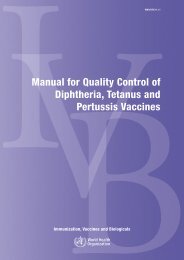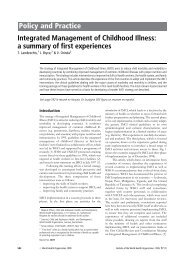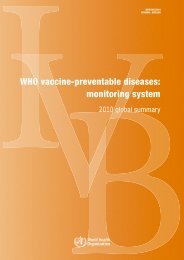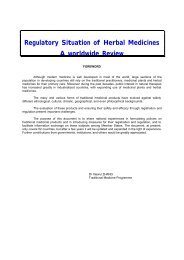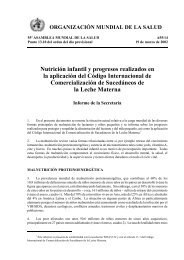IPDE - Extranet Systems - World Health Organization
IPDE - Extranet Systems - World Health Organization
IPDE - Extranet Systems - World Health Organization
Create successful ePaper yourself
Turn your PDF publications into a flip-book with our unique Google optimized e-Paper software.
6 A. A. Dahl and A. Andreoli<br />
of personal and social situations and result in considerable personal distress<br />
or social disruption, they are called PD. They represent extreme or<br />
significant deviations from the way in which the average individual in a<br />
given culture perceives, thinks, feels, and relates to others. They are thus<br />
only quantitatively and not qualitatively different from normal personality.<br />
However, the border between normal and abnormal personalities is<br />
difficult to draw.<br />
The relation to culture and sex<br />
Cultural diversity is a characteristic of human nature. Behavioural patterns<br />
considered normal in one culture are seen as deviant in another. To<br />
identify behavioural panerns that are deviant in all cultures is very difficult.<br />
The PDs primarily reflect the views of Western European and North<br />
American psychiatry and they may not be equally applicable in other<br />
cultures. Role expectations and behaviour, also differ considerably<br />
between the sexes. Problems may arise if psychiatry defines personality<br />
deviance without considering social role expectations.<br />
Unknown personality traits and the use of informants<br />
Many individuals may be unaware of some of their personality traits and<br />
behavioural patterns. Therefore, an individual often can only provide<br />
limited information about him or herself. Heishe may also consciously<br />
try to deny certain socially undesirable personality traits. These problems<br />
can pmially be solved by interviewing an informant who knows<br />
the individual well, but this is still not a standard procedure in the evaluation<br />
of PD. Sometimes informants describe PD-pathology that patients<br />
deny.9 When the accounts of the subject and the informant deviate,<br />
which source of information is more valid? A method of integrating<br />
information from such discrepant reports is needed.<br />
Separate axis and diagnostic criteria<br />
The DSM of Mental Disorders, Thiid Edition (DSM-m)' published by the<br />
American Psychiahic Association in 1980 made two innovations of major<br />
importance for the study of PDs. They were placed on a separate axis<br />
(Axis E), and explicit criteria provided guidelines for the diagnosis of each<br />
of the 11 PDs. The introduction of diagnostic criteria stimulated empirical<br />
research on the reliability of PDs and the optimal diagnostic criteria.




